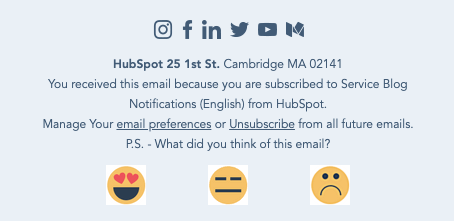Don’t guess. Ask. Survey what readers really think of your emails?
How do you know what the majority of your readers think about your emails after receiving them for a while? Given that the majority of your audience won’t click on an email (a classic success measure) and open rate is diminishing as a measure of engagement, why not simply ask your readers? Here I’ll run through an approach and suggested questions to provide you with direct and honest feedback from your very own audience.
Know your customers
A marketing 101 is to ensure that the most relevant and meaningful message is provided in the most useful way to your prospects and customers. When you send a series of emails over time, what do your potential readers actually think about them? How can you find out if all that time and effort in crafting a well-executed campaign is hitting the mark?
Typically, businesses use response measures to assume a level of ‘satisfaction’ with the emails sent. Open, click and conversion do of course give you a measure of success. But it’s only part of the picture. After all:
- the majority of your audience will not respond to an individual email
- a significant volume of your audience will never respond to an email
- readers who did open and click will stop doing this over time
So to use a metaphor close to my heart
“you can measure the donut, but not the hole.”
Shine a light on the blind spots
You will have a small percentage of readers that you can assume email satisfaction because they have interacted with your email, but will have a large volume of potential readers where there is an insight blind spot. Using a survey can help shine a light on what your audience think of your emails, providing direct feedback and comment. Want to know your customer? Ask them to tell you about themselves!
This need to find alternative ways to gauge satisfaction is even more important now that open rate is becoming less and less reliable. Many businesses have used open rate as an inferred measure of success and engagement. With the introduction of Apples Mail Privacy Protection (MPP) kicking in from now, open rate for a large volume of your readers will become a false positive.
So using open as a measure of engagement is no longer possible. This is not a bad thing as it was always an assumed metric, but making the effort to get first hand feedback from your readers should now be much higher on the priority list.
“Rate this email”
There is an alternative approach to a full survey by including a feedback option on each email you send. A relatively simple solution of adding in a link to allow a reader to provide their opinion.

Something is better than nothing so I’m not going to say don’t do this, but I will raise some considerations when deciding between this approach or a more dedicated survey solution.
- This was is more likely to provide feedback on that specific email
- If repeated every email, readers may become ‘blind’ to this content element
- Adding in additional links to an email can distract from the main Call to Action
Making a survey response the primary purpose
Creating a dedicated survey to gain feedback on your emails provides a number of advantages:
- Asking one thing in your invite is likely to create a much higher response
- A clear value and proposition can be provided to motivate responses
- Questions can be asked considering a number of emails – e.g. send frequency
- Even with a short survey a number of areas can be highlighted for consideration
- Responses can be split by audience type – what do your purchasers think vs. non purchasers
There is an art to creating a good online survey (which is a blog post in itself) As my top three tips I would suggest:
- Be very clear as to how you will use each response – this ensures a clear reason to include the question and the format of the response you choose.
- Keep your basic survey to less than 5 minutes to complete and set this expectation in the invite. You can always add in some additional questions to those responders who are more committed.
- Spend proper thinking time on crafting the invite. Why should the reader bother, what’s in it for them and how will taking the time to complete this make a difference in the future?
Example questions
So you’ve committed to finding out what your customers really think about your emails. Great news. Now what are you going to ask?
Clearly there will be some very specific content and brand considerations to include. However having created a number of these surveys for clients, here are a few recurring questions to make the task a little easier for you.
|
1. Overall, how would you rate our emails |
7-0 scale (From ‘Excellent’ to ‘Very Poor’) |
|
1a. What is the main reason for this |
Free text |
|
2. How well do our subject lines tempt you to open our emails |
Always, Sometimes, Rarely, Never |
|
3. When you click on an email link, do you reach the information you want |
Always, Sometimes, Rarely, Never |
|
4. How do our emails tend to make you feel |
Amused, Angry, Disappointed, Excited, Happy, Indifferent, Intrigued, Unimpressed (Use face icons) |
|
5. What content most interests you |
List of content topics |
|
6. How easy are our emails to read and digest |
Extremely easy, Quite Easy, Not so easy, Not at all easy |
|
7. What could be improved in our emails |
Free text |
|
8. What do you feel about the number of emails we send per month |
Just right, Not right (too many), Not right (not enough) |
|
9. Have you ever been tempted to unsubscribe from our emails |
Yes, No |
|
9a. If yes - why |
Free text |
|
10. If you receive emails from other similar brands, how well do our emails compare |
Much better, Somewhat better, About the same, Somewhat worse, Much worse, Not applicable |
You can see from just these 10 questions how insightful and useful this direct feedback is to you. It enables you to review what to keep from your current approach and what to change.
Different segment different perspective
Using audience survey groups may provide you with further insight based on variations in responses. In the past I sent the same survey questions, but capturing responses separately to:
- Never clicked 3.8% response rate
- Clicked in the last 6 months - but not last month 6.8% response rate
- Clicked in the last 1 month 20.1% response rate
Responses from each engagement group provides insight on the reasons for lack of, as well as actual interaction. Something you simply can’t get using reporting metrics.
Lessons learnt from survey responses have been used to inform a number of strategies from lapsing campaigns to content planning and look and feel considerations.
Don’t guess. Ask.
Enabling your readers to tell you what they like (and don’t like) about your emails is a really valuable tool to all businesses. It removes the assumptions based on simply using reporting metrics and provides great insight from which to either correct parts of your emails that disengage or optimise areas that are creating success.
Deploying a regular (perhaps half yearly) survey plan provides a benchmark of scores by which to judge the impact of your efforts from the last survey send.
An email survey can also be used more tactically, perhaps as part of your onboarding or lapsing strategy. For example, a survey request to anyone who has signed up, but not clicked on an email in the first 3 months. An opportunity for really useful feedback and far more insightful then simply giving them a more traditional ‘ should we keep sending’ email choice.
Survey responses can also feed into wider projects as well as email optimisation. I’ve seen companies use survey findings to help build business cases for martech reviews, the value of content strategy projects as well as customer insight research.
Thank you for your time
We all like to be asked our opinion, but we all need to know that the time we invest is worthwhile. Showing your readers you care about the emails you send is a great first step to covering both of these needs and providing a further point of differentiation from other brands.
And as a business you get first hand insight into how your emails are perceived, a valuable source of insight. Win win right!
 Photo by Emily Morter on Unsplash
Photo by Emily Morter on Unsplash

 How to resolve AdBlock issue?
How to resolve AdBlock issue? 
